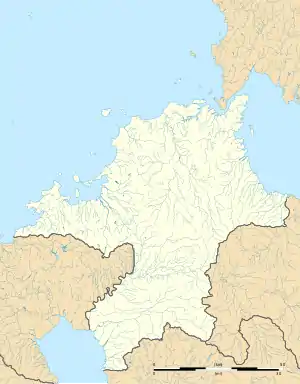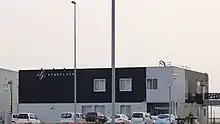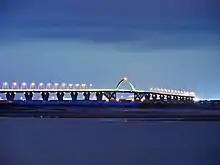Kitakyushu Airport
Kitakyushu Airport (北九州空港, Kitakyūshū-kūkō) (IATA: KKJ, ICAO: RJFR), sometimes called Kokuraminami Airport, is an airport in Kokuraminami-ku, Kitakyushu, Fukuoka, Japan. It is built on an artificial island in the western Seto Inland Sea, 3 km (1.9 mi) away from the city's downtown. It opened on 16 March 2006, as New Kitakyushu Airport (新北九州空港, Shin-kitakyūshū-kūkō) but was renamed in 2008. It is designated a second class airport, and it has some international charter flights.
Kitakyushu Airport 北九州空港 Kitakyūshū-kūkō | |||||||||||
|---|---|---|---|---|---|---|---|---|---|---|---|
 | |||||||||||
| Summary | |||||||||||
| Airport type | Public | ||||||||||
| Operator | Ministry of Transport (airfield) Kitakyushu Air Terminal Co. (terminal) | ||||||||||
| Serves | Kitakyushu, Japan | ||||||||||
| Opened | 16 March 2006 | ||||||||||
| Hub for | StarFlyer | ||||||||||
| Elevation AMSL | 21 ft / 6 m | ||||||||||
| Coordinates | 33°50′44″N 131°02′06″E | ||||||||||
| Map | |||||||||||
 RJFR Location in Fukuoka Prefecture  RJFR Location in Japan | |||||||||||
| Runways | |||||||||||
| |||||||||||
| Statistics (2015) | |||||||||||
| |||||||||||
Source: Japanese Ministry of Land, Infrastructure, Transport and Tourism[1] | |||||||||||
It is the fourth airport in Japan to begin operating 24 hours a day, after New Chitose Airport (Sapporo), Kansai International Airport (Osaka), and Chūbu Centrair International Airport (Nagoya).
History
The former Kitakyushu Airport had restrictions on aircraft operation due to its small size and location, close to mountains and residential areas. Heavy fog often resulted in flight cancellations. There were similar problems at the nearby Fukuoka Airport, which cannot engage in nighttime operations due to proximity to residential areas.
A new airport was intended to be free from such problems due to its offshore location, making possible 24-hour operation. Large cargo planes can use the airport, making possible convenient freight movement to and from nearby industrial zones. Toyota has a factory just across the bay from the airport.
Construction
A committee to promote the construction of the new airport was founded in 1978, with the governor of Fukuoka as chairman. Construction began in October 1994.
The new airport was anticipated by residents in and around the cities of Kitakyushu and Shimonoseki. The Kitakyushu municipal government organized bus tours to the construction site for interested citizens in an attempt to defuse controversy over the construction. The airport officially opened on March 16, 2006.
Flights

The first aircraft to land at the airport was a StarFlyer Airbus on March 26, 2006. The first international flight from Shanghai landed on March 30, 2006. A Korean low-cost carrier, Jeju Air, flew eight charter flights from Kitakyushu to Incheon International Airport in summer 2008. Scheduled service on the route started in March 2009.
Events
Several events were held to commemorate the opening of the airport. A marathon was held on February 5, 2006, with half-marathon, 10 kilometre and five kilometre courses to celebrate the opening of the new airport. On June 4, 2006, a rugby game was played at Honjo Stadium between Japan and Tonga as part of the inaugural IRB Pacific 5 Nations series.
On August 2, 2006, the one-millionth user of the airport was presented with souvenirs. By July 11, 2007, 3 million passengers had used the airport.
Dimensions
The runway is 2,500 by 60 m (8,202 by 197 ft) (with a separate taxiway of 2,500 by 30 m (8,202 by 98 ft)), enough to accommodate Boeing 747s and other large jet aircraft. The manmade island on which the airport is built is 4,125 m (13,533 ft) long and 900 m (2,953 ft) wide (3.73 km2 (1.44 sq mi)). Due to the island's size and the relative shallowness of the surrounding water, which is about 7 m (23 ft) in depth, future expansion will be conducted, starting with a 500m runway extension to 3,000 by 30 m (9,843 by 98 ft)).
Airlines and destinations
Passenger
| Airlines | Destinations |
|---|---|
| Fuji Dream Airlines | Shizuoka |
| Hi Air | Muan[2] |
| Japan Airlines | Tokyo–Haneda |
| Jin Air | Seoul–Incheon |
| StarFlyer | Tokyo–Haneda Charter: Muan,[3] Taipei–Taoyuan[4] |
Cargo
| Airlines | Destinations |
|---|---|
| ANA Cargo | Naha |
| Korean Air Cargo | Los Angeles, Seoul–Incheon[5] |
Other facilities

The airline StarFlyer has its head office on the airport property.[6]
Access

Road
A 2.1 km toll-free bridge connects the island to the Higashikyūshū Expressway via the Kanda-Kitakyushukūkō interchange.
Bus
| Terminal | Via | Note | Operator |
|---|---|---|---|
| Sunatsu | Kokura Station Bus Center | Nishitetsu | |
| Kitakyushu Science and Research Park | Orio, Kurosaki | ||
| Kusami Station | Runs on automated driving[7] | ||
| Hakata Station | Tenjin | only at midnight and early morning | |
| Beppu Station | ends 31 July 2019 | Oita Kotsu, Kamenoi Bus |
References
- "Kitakyushu Airport" (PDF). Japanese Ministry of Land, Infrastructure, Transport and Tourism. Archived from the original (PDF) on 21 October 2016. Retrieved 7 January 2017.
- "하이에어, 무안공항 · 기타큐슈 노선 … '국제선 취항'" [Hi Air, Muan Airport, Kitakyushu Routes… "International flights started."] (in Korean). Kookmin News. 25 May 2023.
- "StarFlyer Adds Kitakyushu – Muan Charters from mid-July 2023".
- "StarFlyer Adds Kitakyushu – Taipei Charters in 1Q23". Aeroroutes. 9 December 2022.
- "대한항공, 일본 기타큐슈 화물기 신규 취항" (in Korean). Korea Logistics News. 26 November 2019.
- "会社概要." StarFlyer. Retrieved on December 20, 2010. "本社 〒800-0306 福岡県北九州市小倉南区空港北町6番 北九州空港スターフライヤー本社ビル"
- About auto operator bus
External links
- Official website Archived 2016-11-06 at the Wayback Machine
- Official website (in Japanese)
- "Official brochure in English about the airport" (PDF). Archived from the original (PDF) on 2007-07-01. (3.89 MiB)
- Current weather for RJFR at NOAA/NWS
- Accident history for KKJ at Aviation Safety Network